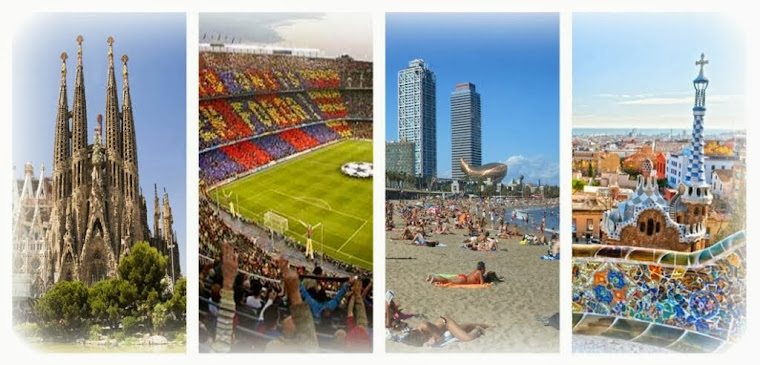Park Güell is synonymous with Barcelona and it’s no surprise it’s one of the top five tourist attractions in the city. Not only does it offer stunning panoramic views, fantastical architecture and beautiful gardens, but you can also discover the house of the great man himself in the grounds of the park.
 |
| Park Güell – Gaudí’s playground |
The dream-like exuberance of Gaudí’s imagination remains breathtaking to this day and as you stroll around you can’t help but admire how skilfully he integrated his work into the landscape. His usual imposing style can be seen throughout the park – bright colours, unusual architectural forms, influences from nature that include natural shapes and curves.
The grounds of the park are pretty big and it can be bit overwhelming on arrival. To make life a little easier, check out our guide on what to see and do during a visit.
 |
| Park Güell – Gaudí’s playground |
The history of Park Güell
Built from 1900 to 1914, the Gaudí Park is situated on the hill of El Carmel in the Gràcia district of Barcelona. Park Güell is part of the UNESCO World Heritage Site called ‘Works of Antoni Gaudí’ along with his other masterpieces such as the Sagrada Família and La Pedrera.
The park was originally commissioned by the Catalan entrepreneur Eusebi Guëll, who wanted around 60 houses built in the style of English garden cities for the wealthy of Barcelona to enjoy. (The English influence can also be seen in the anglicised spelling of ‘park’.)
 |
| Park Güell – Gaudí’s playground |
Work on Park Güell was interrupted by the outbreak of war in 1914 but the idea of a housing estate never really took off due the park’s distance from the city centre. So in 1922 the unfinished estate became the property of the city of Barcelona and is still open to the public today as a municipal park.
Things to see in Park Güell
The two gatehouses – these Hansel and Gretel-like gingerbread houses are what greet visitors who have made the climb to the Gaudí Park. They flank the park entrance and are famous for their fantastical roofs and mushroom-shaped domes with colourful tiling work. Originally there were two, life-size mechanical gazelles at the entrance of Park Güell, but they were unfortunately destroyed during the Civil War.
The staircase - for some, the stairs themselves will not be an attraction but it’s the beautiful fountains on the way up that you should take a look at. The infamous salamander or drac is one of them and like a lot of the Park, it’s decorated in broken ceramics and glass in a mosaic style known as trencadís. It’s one of the most popular photo spots in the whole park and you often have to queue for a quick snap.
 |
| Park Güell – Gaudí’s playground |
Room of 100 Columns’ – 100 Doric columns hold up the square above and provide a shady pavilion from the summer heat. If you look to the ceiling you’ll find numerous coves, elaborated with religious, mythological and astrological symbols.
The serpentine bench – this beautiful tiled bench surrounds the viewing terrace or main square and is supposedly the longest bench in the world. It’s a great place to sit back, relax and admire the spectacular view of the city and the Mediterranean Sea in the distance. The benches themselves are covered in an array of unique mosaics, delicately created by Gaudí’s assistant Josep Maria Jujol.
Gaudí museum – the Museum, otherwise known as Casa Museu Gaudí, can also be found in the grounds of Park Güell. It was his home between 1906 and 1926 and today it’s open to the public for a small fee. Among the artefacts inside are furniture and mirrors from the other Gaudí buildings such as Casa Batlló, the Pedrera and Palau Güell, as well as the artist’s wardrobe, bed and personal possessions.
 |
| Park Güell – Gaudí’s playground |
The peak – the stone cross at the top of Park Güell marks its highest point and it’s here that you’ll find extraordinary panoramic views of the city. On a sunny day you can spot the majority of Barcelona’s most famous landmarks – Sagrada Familia, Agbar Tower, Camp Nou and of course the Mediterranean Sea. It is an unforgettable sight and the perfect way to start or finish a trip to Park Güell.
How to get to Park Güell
You wouldn’t get the spectacular vistas you do in Park Güell without its hill-top location, but it’s this hill-top location that makes getting to it a little tricky at times, especially on a hot day! The main Park Güell metro stop is Lesseps however it involves a 20-minute uphill walk to the entrance of the Gaudí Park. A top tip is to go one stop further on the metro to Vallcarca, catch the escalators up to the cross at the park’s highest point and then head down into the park. You will essentially see the Park in reverse and end up leaving through the entrance but it does mean you walk down the hills instead of up!
 |
| Park Güell – Gaudí’s playground |
Another option which is great if you are sightseeing with children or the elderly is to take the bus. Bus No. 24 drops you directly outside Park Güell’s entrance and goes from Plaça Catalunya and Poble Sec, while bus No. 92 does the same but goes from Glòries & Port Olympic. Other buses that will drop you nearby are 31, 32, H6 and 112.
Park Güell opening hours
January to March – 10:00 to 18:00
April – 10:00 to 20:00
May to September – 10:00 to 21:00
October – 10:00 to 20:00
November – 10:00 to 19:00
December – 10:00 to 18:00
 |
| Park Güell – Gaudí’s playground |
Park Güell prices
From october 2013, Park Güell entrance has a cost.



























